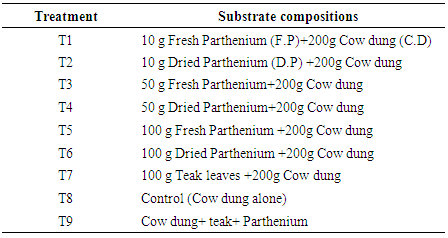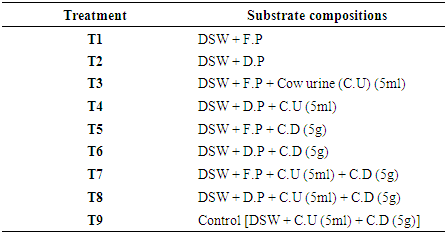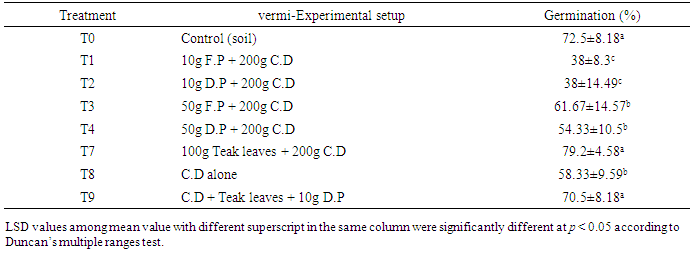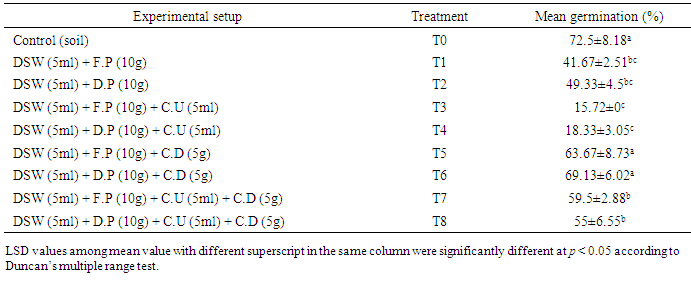-
Paper Information
- Previous Paper
- Paper Submission
-
Journal Information
- About This Journal
- Editorial Board
- Current Issue
- Archive
- Author Guidelines
- Contact Us
International Journal of Agriculture and Forestry
p-ISSN: 2165-882X e-ISSN: 2165-8846
2018; 8(4): 160-170
doi:10.5923/j.ijaf.20180804.05

GPS Based Density and Distribution Mapping and Composting a Sustainable Approach for Monitoring and Managing Parthenium (Parthenium hysterophorus L.) in Northern Sri Lanka
Kishojini P., Pakeerathan K., Mikunthan G.
Department of Agricultural Biology, Faculty of Agriculture, University of Jaffna, Ariviyal Nagar, Kilinochchi, Sri Lanka
Correspondence to: Pakeerathan K., Department of Agricultural Biology, Faculty of Agriculture, University of Jaffna, Ariviyal Nagar, Kilinochchi, Sri Lanka.
| Email: |  |
Copyright © 2018 The Author(s). Published by Scientific & Academic Publishing.
This work is licensed under the Creative Commons Attribution International License (CC BY).
http://creativecommons.org/licenses/by/4.0/

The silent habitat invader Parthenium is a most important problematic weed to native biodiversity and agriculture. Its accidental incursion and quick adaptation in Northern Sri Lanka is considered to be the major threat to the dry-zone agriculture. There is an urgent need for controlling this herbicide tolerant noxious weed to prevent economic crop losses due to allelopathic effect. Investigations were planned for distribution and density mapping and; to manage the Parthenium through bio-composting as substitute for environmentally harmful inorganic fertilizer. For the density based distribution mapping, Geographical Positioning System (GPS) device and 1 m2 quadrat were used. For vermi and distillery spent wash (DSW) composting, proportionate Parthenuium, cow dung, cow urine, teak leaf, mixed substrates were evaluated in different experiments. Compost performance were evaluated by setting seed germination experiment. The results showed that highest density of Parthenium was found in Jaffna district, whereas itwas not found in Mannardistrict. study was identified that this weed rapidly spreading and invading the new places in Kilinochchi and Mullaithevu districts and; Karainagar, Mathagal, Kangesanthurai, Valveddithurai, Pointpedro, Jaffnatown, Kaithady and Chavakachcheri of Jaffna disrict. In the vemi-coposting of Parthenium investigation, treatments used were significantly different from other at P > 0.05. Cocoon production and worm multiplication was high in 10g FreshParthenium + 200g cow dung treatment. Amaranthus seed germination was highly significant in 100g Teak leaves +200g cow dung + 10g Dry Parthenium treatment with the mean of 70.5±8.18 whereas no any germination was recorded in 100g Fresh Parthenium + 200g cow dung and; 100g Dry Parthenium + 200g cow dung treatments. In distillery spent wash compost Amaranthus germination was highly significant in distillery spent wash (5ml) + Dry Parthenium (10g) + cow dung (5g) with the mean of 69.13 ± 6.02. But in distillery spent wash (5ml) + Fresh Parthenium (10g) + cow urine (5ml) and distillery spent wash (5ml) + Dry Parthenium (10g) + cow urine (5ml) treatments germination percentage was significantly very lower. This investigations concluded that Parthenium is invading very quickly to new lands. Allopathic chemicals present in the fresh Parthenium is detrimental to earthworm as well as seed germination. Optimum level of dry Parthenium can be used for the production of compost with the different combinations of other bio-rationales to minimize the usage of inorganic chemicals as well as to alleviate this weed from the ecosystem.
Keywords: Parthenium, Amaranthus, Earthworm, Distellary spent wash, GPS
Cite this paper: Kishojini P., Pakeerathan K., Mikunthan G., GPS Based Density and Distribution Mapping and Composting a Sustainable Approach for Monitoring and Managing Parthenium (Parthenium hysterophorus L.) in Northern Sri Lanka, International Journal of Agriculture and Forestry, Vol. 8 No. 4, 2018, pp. 160-170. doi: 10.5923/j.ijaf.20180804.05.
Article Outline
1. Introduction
- Asteraceae family member Parthenium (Parthenium hysterophorus L.) is a one of the world's top seven most aggressive weeds (Gnanavel, 2013). It is native to tropical America. Botanically, Parthenium is a resilient plant, therefore, it can grow in a wide range of soil and climatic conditions (Khaket et al., 2012; Evans, 1987). Kaur et al. (2014) reported that Parthenium has been invaded more than 30 countries around the globe, including five continents and numerous islands within short period of time using its own biological power. This weed known by several region specific common names such as congress weed, rag weed, altamisa, carrot grass, Santa Maria, bitter weed, star weed, white top, wild feverfew and gajar ghas, the “scourge of India” (Saini et al., 2014). Parthenium has numerous beneficial chemical and pharmacological properties including anti-cancer effects, antioxidant and anti-inflammatory activities (Pandey et al., 2012; Saini et al., 2014; Venkataiah et al., 2003), hypoglycemic activity (Patel et al., 2008), antibacterial activity against Staphylococcus spp., Salmonella spp., Escherichia coli, Serratia spp., and Bacillus spp. (Feresin et al., 2000), anti-parasitic effect on Plasmodium falciparum (Rodríguez-Pérez et al., 2006) and etc.. Even though, it has international and national significance due its ability to pose constant threat and huge economic damage to agriculture, animal husbandry and eco-system (Anonimus 2003; Gnanavel 2013; Saini et al., 2014). Parthenium invaded into Sri Lanka from India while Indian Peace Keeping Force (IPKF) entered in 1987 and was reported first time from the Vavuniya district in Sri Lanka (Jayasuriya, 1999; Wijesundara, 2010). It has invaded rapidly in Northern Sri Lanka due to lack of concern and awareness about the deleterious impact of this noxious weed among the farmers and citizens. However, information available about its scenario in Sri Lanka is yet not updated and such information is essential to plan and implement the appropriate control strategies for its eradication. The study of distribution pattern of Parthenium is the most important measurement to monitor an alien weed for its existence, invasion capabilities. To manage this weed several approaches such as quarantine, cultural, physical and chemical were implemented sofar. Among the tactics, chemical approach was a preferred mean in past two decades. But in Sri Lanka, many potential herbicides has been banned recently because of growing concern about chronic kidney disease of unknown etiology (CKDu) due to adverse impacts of agrochemicals. Moreover, a lot of research findings all around the globe has also been reported on the long term adverse impacts of chemical fertilizers on soil fertility. Use of organic fertilizers had been shown to be a good means of improving soil quality and promoting sustainable agriculture (Rezende et al., 2014). Controlling Parthenium by composting and providing nutrients to the desired crops will be an ecofriendly step. Although, enough quantity of various essential macro and micro plant nutrients is present in Parthenium compost; but, it is not commonly practiced by farmers. Compost of this weed has been made with variety of organic wastes using different methods. Composting might be a useful alternative to convert the weed biomass as soil conditioner (Anbalagan and Manivannan, 2012; Jelin and Dhanarajan, 2013). Considering current scenario of Parthenium, an investigations were planned to map its distribution using sophisticated GPS device; to measure its density using quadrate; to composting of this weed using different ways and to measure the effect of Parthenium based compost on plant growth.
2. Material and Methods
- To study the Parthenium distribution and density, a preliminary exploration was conducted all the districts such as Jaffna, Kilinochchi, Mullaithevu, Vavuniya and Mannar in Northern Sri Lanka. Preliminary survey data identified sampling sites were chosen to construct distribution and its location based density maps of Parthenium using advanced sophisticated tools. Parthenium management experiments through compost making were also performed.
2.1. Geographical Positioning System (GPS) Based Mapping
- All identified districts were classified into Divisional Secretariat (DS) division. Location of Parthenium plants were accurately positioned and exact coordinate points indicating distribution of Parthenium was taken with the help of GPS device (Fig. 1). The GPS reading was used to draw district wise Parthenium distribution and intensity maps using Arc_GIS software.
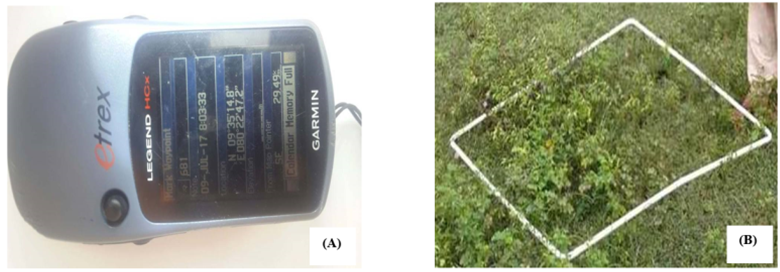 | Figure 1. (A) GPS device and (B) Quadrat used |
2.2. Determining Density of Parthenium
- To determine intensity and density of Parthenium in each GPS identified location, quadrate sampling was performed in the randomly selected DS divisions of each district. Readings was taken by throwing 1 m2 plastic quadrate. Each sampling points were replicated five times to minimize the error. For the calculation of intensity and density of Parthenium, following formulas were used [Raunkaier (1934); Stromberg (1993)].

2.3. Composting of Parthenium for Management
- An investigation was planned for the preparation of Parthenium based compost at the experimental unit in the Department of Agricultural Biology, University of Jaffna, Sri Lanka. Parthenium seedlings (vegetative stage before flowering) were collected from in and around fallow lands of Vaddukoddai, Jaffna, Sri Lanka located in between 9°44′0″N and 79°57′0″E and were mixed in proportions with different substituents to facilitate the quick composting process. All the trials were conducted and maintained at room temperature of 27°C at 70% RH.
2.3.1. Mixture 1: Parthenium Plants + Cow Dung + Earthworm (Eisenia foetida)
- Equal amount of fresh cow dung collected from a farm house was mixed with different amount of chopped Parthenium plants (Treatment) to make substrate for composting (Table 1). Moreover, control and Teak mixed substrates were also used to compare with treatment. Each treatment was replicated three times to minimize the error. Equal number (10) of E. foetida was released into the pre-prepared 21 days old substrate mix and entire system was allowed for composting nearly 30 days. Within the time line, growth and multiplication rate of worms were measured. The compost was allowed for tyndallization to kill weed seeds.
|
2.3.2. Mixture 2: Parthenium Leaves + Cow Urine + Cow Dung + Distillery Spent Wash
- Equal amount (10 g) of fresh and dried chopped Parthenium plants were mixed with constant amount (5 ml) of Distillery Spent Wash (DSW). Moreover, cow urine and cow dung mixed substrates as treatments were also compared (Table 2).
|
2.4. Impact of Parthenium Based Compost on Seed Germination
- One portion compost from each treatments was mixed individually with the ten portion tyndallized soil into 1 Kg capacity pots and Amaranthus seeds were planted with three replicates. Standard agronomic conditions for seed germination and practices for growth were provided.
2.5. Experimental Design and Statistical Analysis
- All the experiments were conducted using Complete Randomized Design (CRD). Analysis of variance (ANOVA) was performed in SAS software version 9.4 (SAS Institute Inc., Cary, NC, USA). Duncan’s least significant differences (LSD) test among the treatments were calculated to show the best treatment using the same software.
3. Results
- Identification and exploration of dispersal pattern of alien weeds and its mapping will give a complete picture for monitoring and its eco-friendly management or eradication of such weed. Current investigations identified the following findings.
3.1. Geographical Positioning System (GPS) Based Mapping of Parthenium
- Distribution of noxious weed Parthenium was studied in Jaffna, Kilinochchi, Mullaithevu, Vavuniya, and Mannar districts of Northern Sri Lanka. Results of current study through surveying revealed that highest density was noticed in Jaffna peninsula and Vavuniya district as well as lowest density was recorded in Mullaithevu district. Moreover, density of this weed was moderate in Kilinochchi district. Availability of Parthenium was not noticed anywhere in Mannar district (Fig. 2).
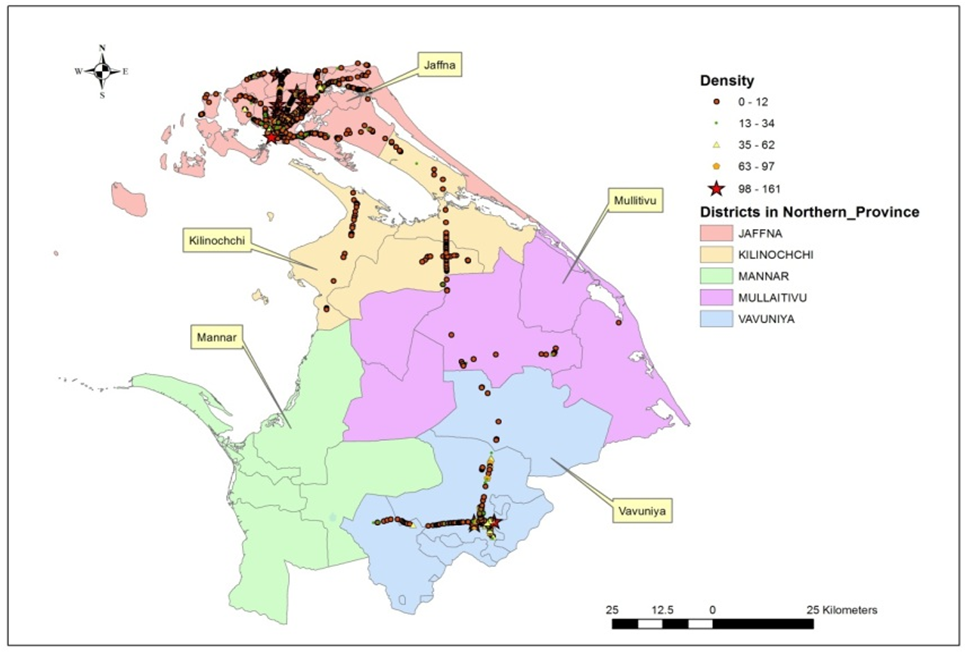 | Figure 2. Existence and intensity of Parthenium in Northern province of Sri Lanka |
3.2. Parthenium’s scenario in Jaffna District
- Distribution of this weed with in the Jaffna was mainly mapped along the K.K.S road, Puththur road, Point-pedro, Kaithady, Vaddukoddai, Siruppiddy and Udivil road adjacent to cultivable and barren land (Fig. 3). Survey results exhibited that four major DS divisions in Jaffna district (Valikamam, Vadamarachi, Thenmarachi, and Jaffna town) considerably infested with this weed. But Parthenium density was low in and around Islands. Among the DS divisions, lowest and highest density was noticed in Vadamarachi and Valikamam, respectively. Even though, the distribution points on map indicated that weed intensity was lower in Vadamarachchi than Valikamam DS division where Parthenium density was 112-161 per m2 (Nilavarai, Puttuur-very high) (Fig. 3, 4). Very low density was observed in Karainagar. Within the Jaffna Division, the weed distribution was recorded in Jaffna town fort area, Kakkaithevu, Navanthurai (Fig. 4).
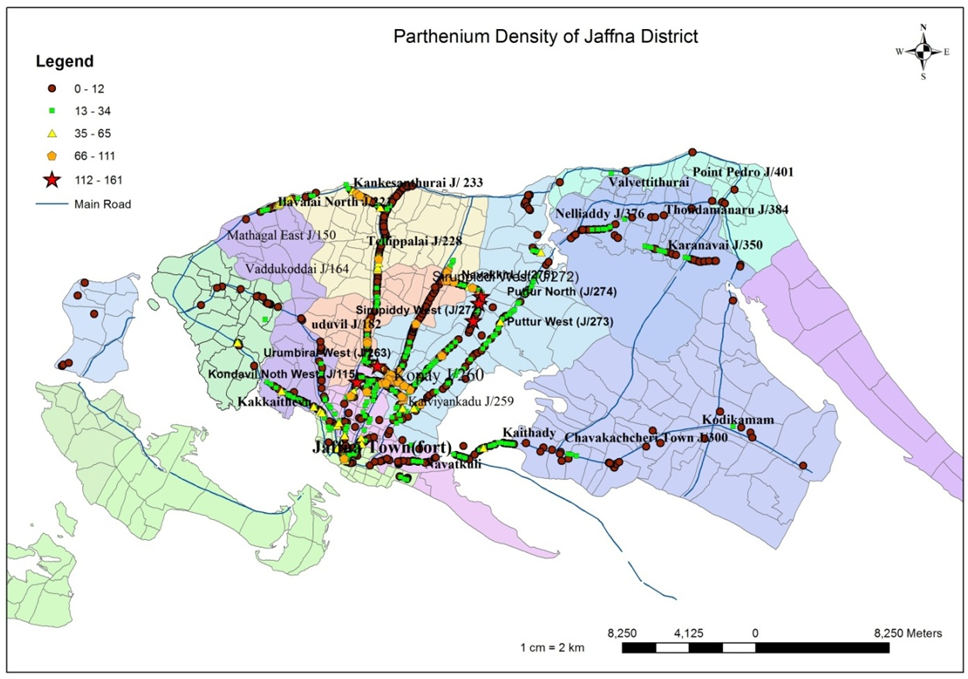 | Figure 3. Parthenium distribution in Jaffna district |
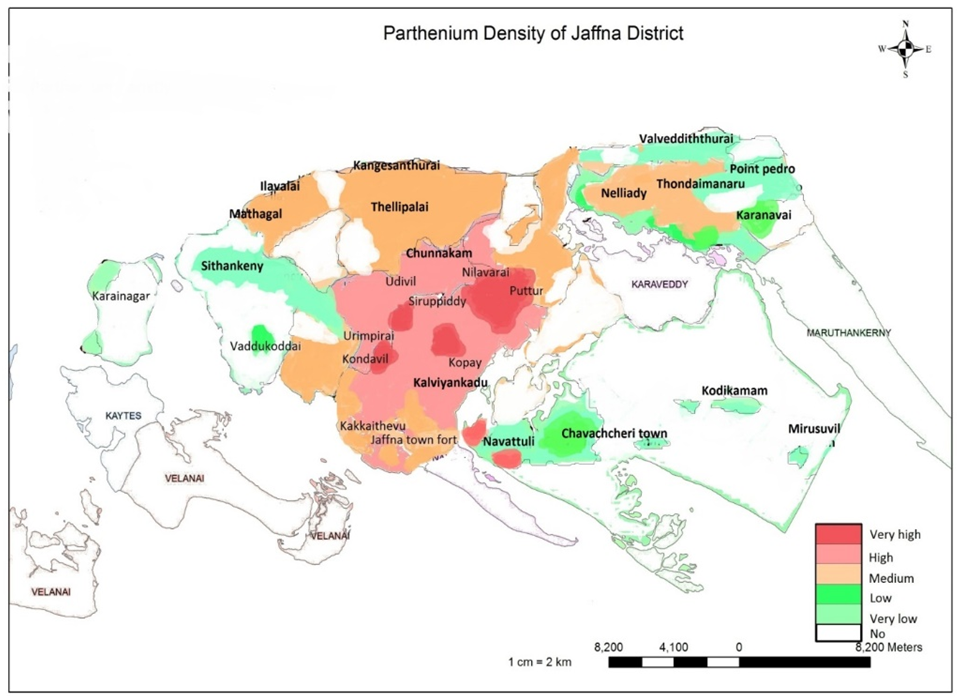 | Figure 4. Parthenium density in Jaffna district |
3.3. Status of Parthenium in Kilinochchi District
- In Kilinochchi district existence of Parthenium was observed at Pachchilaipalali DS division which includes (Pallai Town KN/87, Muhamalai KN/93), Kandavalai DS division (Paranthan Town KN/44, Urithirapuram West KN/34), Karachchi DS division (Kilinochchi Town KN/23, Kanagapuram KN/26, Iranamadu) and Pooneryn DS division (Poonakary town, Mulankavil KN/73). Among the above mentioned places, Parthenium density was high in Karachchi DS division (Fig. 5).
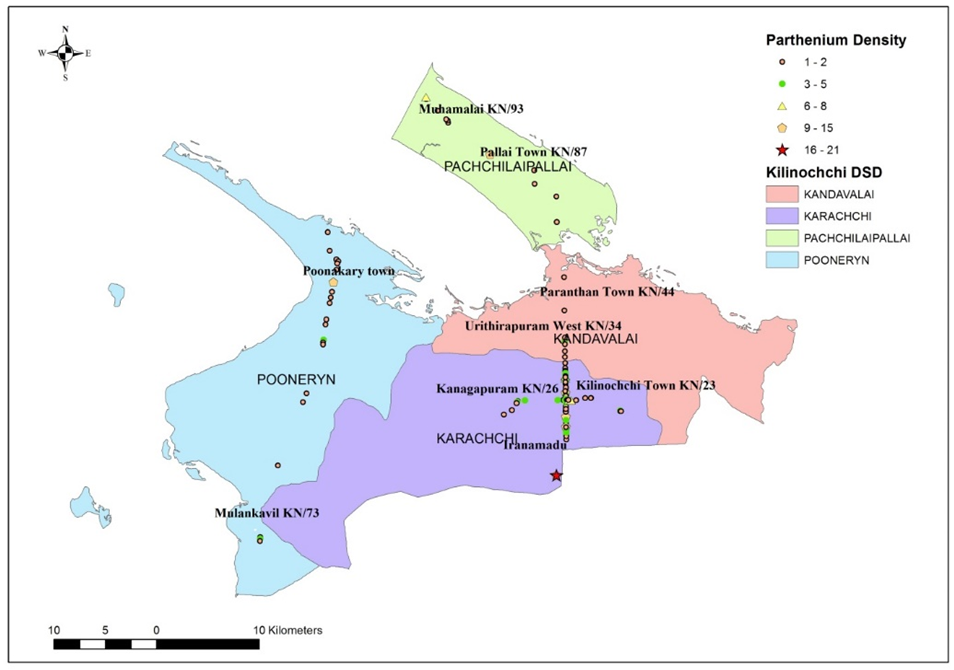 | Figure 5. Parthenium density distribution in Kilinochchi district |
3.4. Parthenium Scenario in Mullaithevu District
- In Mullaithevu district Parthenium was observed in Thanniyuttu, Oddisuddan town, Mankulam and Murukandy but the density was high in Oddusuddan town (26-35 per m2) (Fig. 6).
 | Figure 6. Parthenium density distribution in Mullaithevu district |
3.5. Parthenium Status in Vavunia District
- In Vavuniya district existence of Parthenium was heavy mostly towards the center of the district which includes Omanthai 220D, Vavuniya Town 214, Thandikulam 214A, and Poovarasankulam 217A, Kovilkulam 244C, Pandarikkulam 214E, Velankulam 217 D and Poonthoddam) and the villages surrounding the town. Existence of Parthenium was observed in Kanagarayankulam (225), Piliyankulam (224 A) of Vavuniya north DS division (Fig. 7) but the density was less (0-11 per m2).
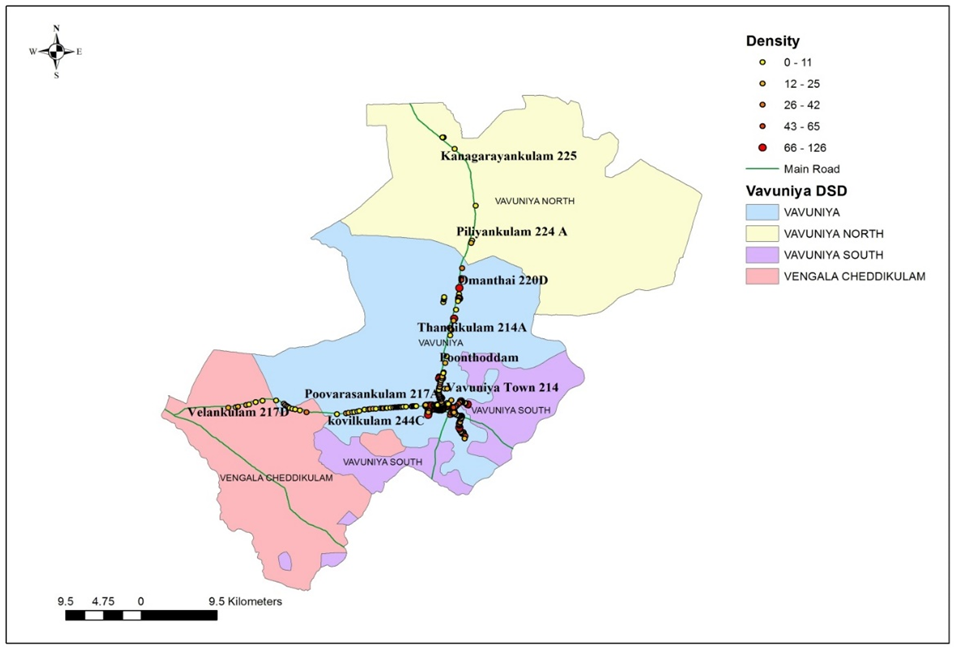 | Figure 7. Parthenium density distribution in Vavuniya district |
3.6. Composting of Parthenium
- Due to alleopathic nature, the Parthenium tend to reduce the economic value of cultivated crops as well as cause harmful effect on human and animals. Hence, it is essential to manage this weed in order to safeguard the crops. Eco-friendly management of Parthenium through compost making with different substrates resulted following findings.
3.6.1. Vermi-composting of Parthenium
- In this investigation compatibility of Parthenium and E. foetida was measured indirectly. E. foetida growth rate revealed that the treatments (T) used were significantly on par among them at P > 0.05 (Fig. 8). Rate of worm reproduction was measured by counting cocoon and number of hatchlings emerged. Results exhibited that the cocoon production was not significantly different in T1, T2, T7 and T9 but maximum cocoon was counted in T7 with the mean of 7 ± 1 where as in T1 and T9 cocoon formation were also considerably high with the mean of 6.33 and 6, respectively (Table 3). Reproduction was not significantly different in T7, T8 and T9 but highest number of hatchling was observed in T7 (9 ± 3) whereas T8 was identified as the second best medium for earth worm hatching process. Worms released in to T5 and T6 were died within a day and the population was zero. Very less multiplication of worms was recorded in T4 with the mean of 10.33 ± 0.58 (Table 3). The worm population was highest (18.33 ± 1.53) in T9. Worms’s population was nearly equal in T7 and T8 with the mean of 17.67 and 16.67 respectively.
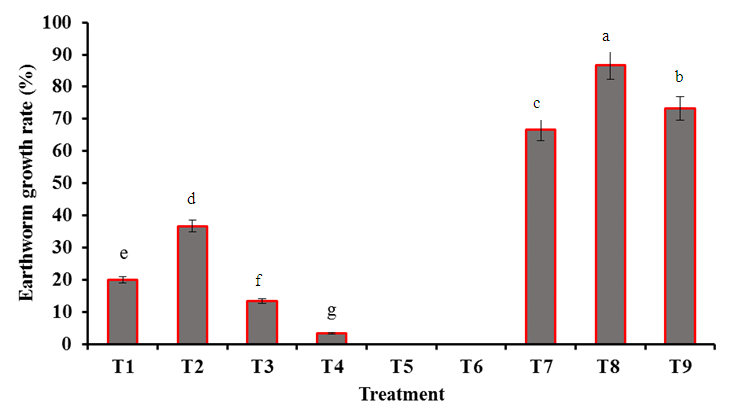 | Figure 8. Worm growth rate in different treatments |
|
3.6.2. Measure the Effect of Parthenium Based Vermin-Compost on Amaranthus Germination
- Vermi-compost derived from the all the experiment (T1-T9) was evaluated. Number of seeds of Amaranthus emerged after a week were counted. Germination percentage was high in T7 with the mean of 79.2 ± 4.58 whereas no any germination was recorded in T5 and T6 (Table 4). In T8 germination was 58.33 ± 9.59 percentage this results was contradictory needs further examination. Germination was declined when Parthenium concentration increase but there was no significant different was observed when compare dry and fresh Parthenium leaves. Similar germination percentage of 38 ± 8.3 were recorded in T1 and T2 indicating that the usage of 10 g fresh or dry leaves did not significantly effect on compost process.(Table 4).
|
3.6.3. Measure the Effect of Distillery Spent Wash Compost on Amaranthus Germination in
- In this experiment Amaranthus germination was high in T6) with the mean of 69.13 ± 6.02. But in T3 and T4 germination percentage was significantly very low than others (Table 5) because incorporation of Parthenium and Cow urine was suppress the Amaranthus germination rate. Whereas the germination percentage was significantly higher in T7 and T8.
|
4. Discussion
- Monitoring of alien weed into the new territory is crucial to understand its potential to survive and adapt into the new environment, further dispersal and choose best management option. Mapping of Parthenium can be possible through several methods but the application of GPS device is a novel, easy and least cost technique.Current investigation identified that the distribution of Parthenium with in the Jaffna district is higher than the earlier study in 2011 (Kavinthan, 2011). But current study, the weed spreading pattern varied and spreaded mainly along the major high ways. Moreover, new invested areas such as Karainagar, Mathagal, Kangesanthurai, Valveddithurai, Jaffna town and Kaithady road have been noticed and mapped. Existence of Parthenium in isolated Municipal wastages dumping places such as Kakkaithevu, Sonnappu (Thondamanaru) has also been recorded (Fig. 9). Low density (0-34 plant/m2) of this weed in these new invaded areas indicating the recent spread. Kavinthan, 2011 reported that the Parthenium was distributed in a triangular area bordering K.K.S road, Puththur road and Point-pedro road. Moreover, its dispersal North-Eastern Jaffna peninsula towards the South-Eastern such as Kopay-Kaithady road up to Kaithady junction and hedges of the highways were hotspots for the dispersal source. Parthenium dispersal in western region of Jaffna such as Vaddukoddai and Karainagar; North-Western areas Mathagal and K.K.S road was also been noticed but this was not recorded in 2011 (Kavinthan, 2011).
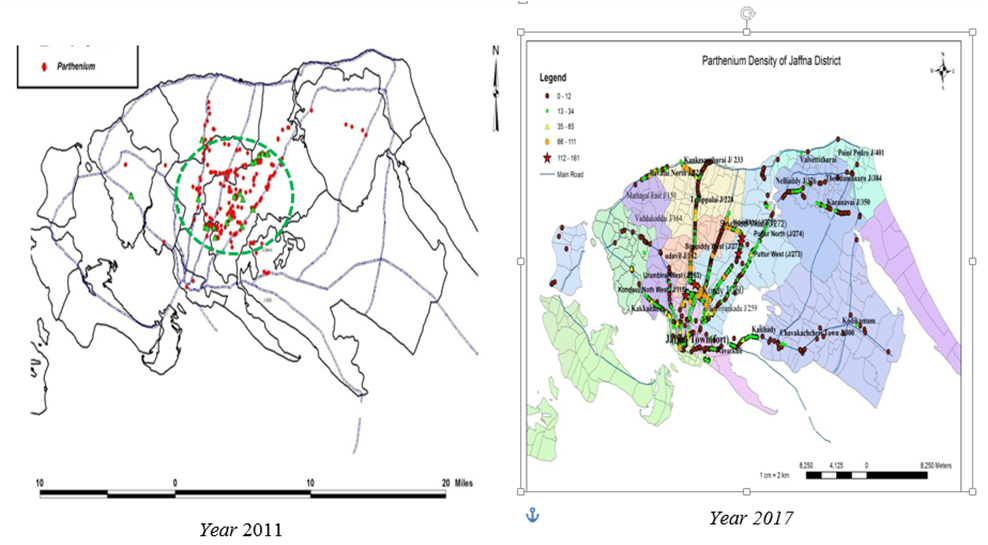 | Figure 9. Comparison of Parthenium distribution in 2011 and 2017 in Jaffna district |
 | Figure 10. Comparison of Parthenium distribution in 2011 and 2017 in Vavuniya district |
 | Figure 11. Livestock feed on Parthenium |
5. Conclusions
- This investigation reports Parthenium has been distributed four districts of nothern provience, except Mannar. Parthenium distribution can be monitored and mapped effectively using sophisticated GPS device. Parthenium density and intensity is very high in Jaffna district. Parthenium is spreading quickly along the highways and invading in to new localities with the facilitation of moving heavy vehicles, wind and wild and/or farm animals. Alleviation of existing Parthenium can be possible by making compost.
ACKNOWLEDGEMENTS
- All authors thank to Mr.K.Venugoban, Instructor, Computer Unit, Faculty of Agriculture, University of Jaffna for his assistance in mapping.
 Abstract
Abstract Reference
Reference Full-Text PDF
Full-Text PDF Full-text HTML
Full-text HTML